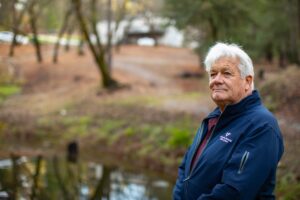In memory of Patrick Nollan, champion for property rights

We have sad news to share: Our client Patrick Nollan—the courageous plaintiff in Nollan v. California Coastal Commission, PLF’s first Supreme Court victory—passed away earlier this month at the age of 76. We offer the Nollan family our deepest condolences. Patrick Nollan’s portrait hangs in our office as an inspiring reminder of his battle for property rights. In the photo, Pat is smiling under the sun, standing on the coast where he won his right to build his home.
We’ve pulled some stories from our archives that help paint a picture of who Pat was and what his landmark case meant for the country.
From Sword&Scales, “How a California family man defeated the bureaucrats stopping him from building his dream home, and changed property rights law forever,” Summer 2020
By Jaclyn Boudreau, PLF Creative Director
One hour each way, five days a week—that’s how long Patrick Nollan commuted from his family’s Ventura County beach house to his job in Los Angeles, where he worked in the city attorney’s office. That’s 70 miles each way, 10 hours per week in the car, at least.
Totally worth it, he figured. He could still be home in time to watch the sun set over the Pacific Ocean from his deck, which is just one hell of a view.
Pat and his wife Marilyn had leased the beach property, with its direct shoreline access and expansive ocean views, as a weekend getaway. But they loved it so much that as the lease ended, they exercised their option to buy the lot, with the idea of making it their permanent home. That required replacing the existing one-story structure on the beach lot with a slightly larger two-story house to accommodate the family.
The county permits for the rebuild weren’t hard to obtain. But because the land was in the coastal zone, rebuilding also required CCC approval. The commission was (and still is) notorious for making extreme demands on homeowners who seek to build anything even remotely near the coast. Patrick Nollan knew that. What he didn’t know, when he submitted his application in February 1982 to demolish the bungalow and build the new home, was that he was starting a fight that would consume the next half-decade of his life.
The CCC granted the permit—but with a rather substantial demand attached. The commission claimed the proposed second story on the Nollans’ property created a “psychological barrier” to the ocean. The CCC demanded, as a condition of issuing the permit, that the Nollans grant an easement to the state for public access to the beach.
That meant the Nollans would be required to dedicate the entire beach area of the property for public access. It would be their gift to the state of California, so to speak—and the CCC had no intention of compensating them.
Pat didn’t like the deal—that “psychological barrier” business, in particular, sounded like a lot of vague nonsense. But the CCC had a nearly unbeaten record in court. So he accepted their terms and signed the permit agreement.
Still, the CCC’s demands stuck in his craw. And then, only after submitting the signed permit agreement, Pat came across an appellate decision detailing a case the CCC actually lost in court. So he thought: If they lost once, they could lose again.
Pat called the law firm that won that appellate case, Pacific Legal Foundation, and asked if they’d take his case. PLF attorneys were interested, but because he’d already signed the permit agreement with the CCC, there was nothing they could do. If he hadn’t signed, the attorneys explained, they could sue, but now he was out of luck.
So Pat took matters into his own hands. He went to the CCC’s office and told the secretary he messed up his permit application. She handed him the unprocessed application, he took it, walked outside, and ripped it to shreds. And remember, this is the 1980s, well before everything was computerized, so destroying that paper application meant it no longer existed. The slate was clean.
Then he called back PLF: “OK, I just ripped up my permit application. Will you take my case now?” Patrick Nollan had entered the fight.
From The Los Angeles Times, “High Court to Decide Beach Access Question,” March 29, 1987
“If the state can just take your property, I think that’s wrong. It’s a basic issue of fairness,” said Patrick Nollan, a deputy city attorney in Los Angeles, sitting on his patio. “The way I read the Fifth Amendment, if the public wants the property, it has to pay for it.”
When the Nollans decided in 1982 to tear down a cottage on their lot and replace it with a three-bedroom house, Coastal Commission officials said they must sign a deed restriction giving the public the right “to pass and repass” on the dry, sandy beach in front of their home.
By common law dating back to Roman times, the public owns the shoreline up to the mean high tide line. In California and most other states, however, the dry portion of beach above the high water mark can be privately owned.
Nollan contested the deed restriction, first in a hearing before the Coastal Commission and then in state courts. Two courts differed on whether building a larger house on the same property was a development that should keep the public off the beach.
A court in Ventura, ruling for Nollan, said it was not. “The commission may constitutionally require a grant of public access only when the facts in the case before it demonstrate that a proposed development will place a burden on the public access to the coast,” a judge said.
A state appeals court disagreed. It said that any development, no matter how small, can be seen as “one brick in a wall” between the public and the beach. The California Supreme Court upheld this decision.
Nollan’s attorneys say that, under this theory, government can do as it pleases any time someone wants to build on his property.
“The California courts have created a handy fiction which makes it possible for the state to acquire private property without paying for it,” said the Pacific Legal Foundation, which appealed Nollan’s case to the Supreme Court.
From Sword&Scales, “Drawing a line in the sand for private property rights,” Fall 2017
By Robert Best, PLF Trustee & Lead Attorney in Nollan
Presenting the Nollan case to the Supreme Court was a major challenge. There was no controlling precedent. We were asking the Court to make new law. Because the Court had recognized the states to have broad powers to regulate land use, we had to establish that the commission was confiscating Patrick Nollan’s property right to exclude others from his land. It was not regulating the use of his land.
We stressed during oral argument that the distinguishing factor between lawful dedications and unlawful exactions is “whether the property owner is creating a burden or not, and the exaction is solely for the purpose of relieving that burden.” Justice Stevens, who authored a dissent, repeatedly pushed the idea that there is no real difference between a regulation prohibiting the placement of a no trespassing sign and the property dedication required of Nollan. My response thankfully carried the day with the majority on the Court.
“Justice Stevens, I want to emphasize, the Nollans feel there is a big difference between being told not to do something on their property, and being told to allow somebody else to do something on their property.”
In the end we made new law, benefiting property owners across the land. The Court’s opinion held the exaction demanded by the commission was unconstitutional because Nollan had created no burden on the public that the exaction would relieve. In the Court’s words, requiring a property dedication in this circumstance would amount to “extortion.”
From the Supreme Court’s opinion in Nollan v. California Coastal Commission (1987)
By Justice Antonin Scalia
It is quite impossible to understand how a requirement that people already on the public beaches be able to walk across the Nollans’ property reduces any obstacles to viewing the beach created by the new house. It is also impossible to understand how it lowers any “psychological barrier” to using the public beaches, or how it helps to remedy any additional congestion on them caused by construction of the Nollans’ new house. We therefore find that the commission’s imposition of the permit condition cannot be treated as an exercise of its land use power for any of these purposes.
From Sword&Scales, “How PLF is still leading the way for property rights,” Fall 2017
By Jim Burling
Government cannot steal. That was the essence of Justice Scalia’s majority opinion in Nollan v. California Coastal Commission. If government demands someone’s property in exchange for a permit, then the taking of the property must reduce a serious harm caused by the permitted development. It’s not enough that the government might want the property for “the public good.” Instead, the taking must directly reverse a harm that would otherwise be caused by the development.













